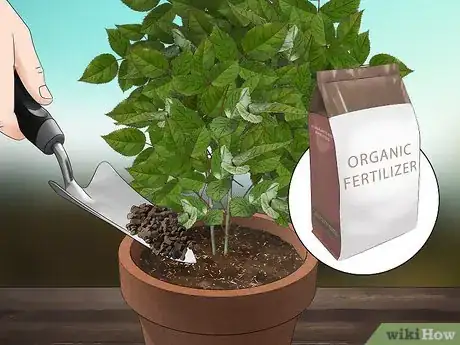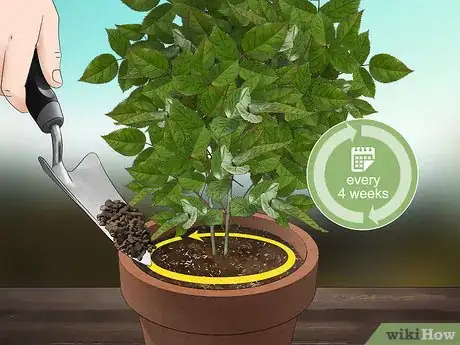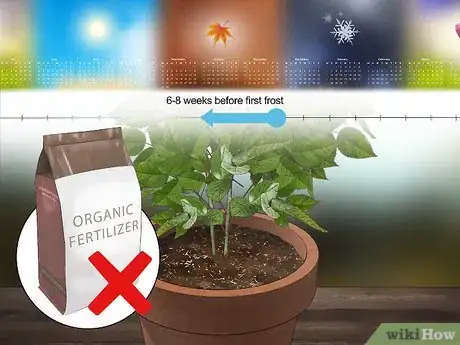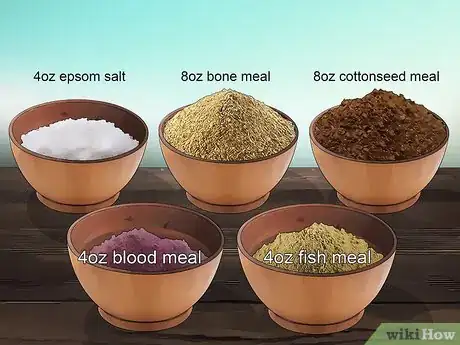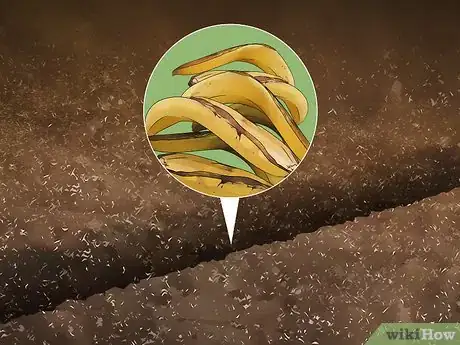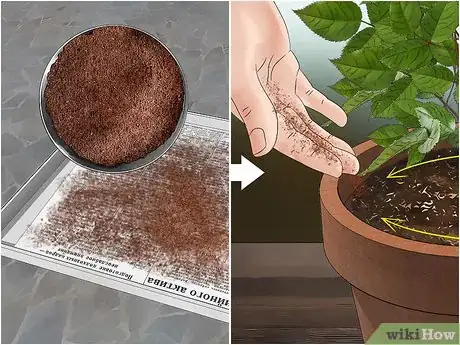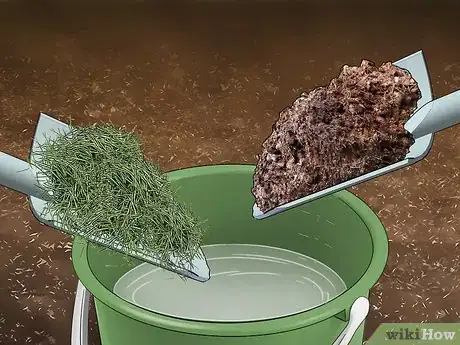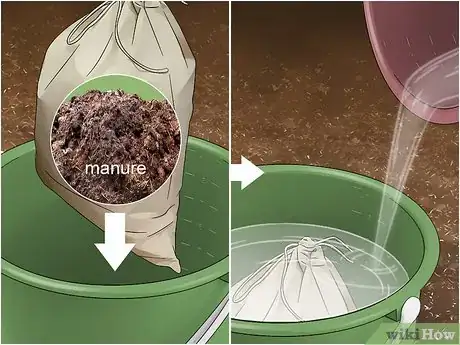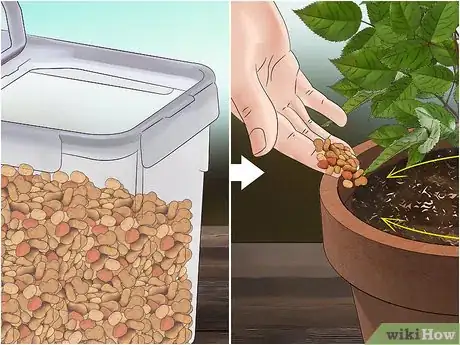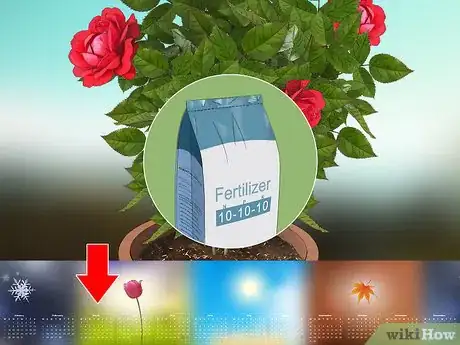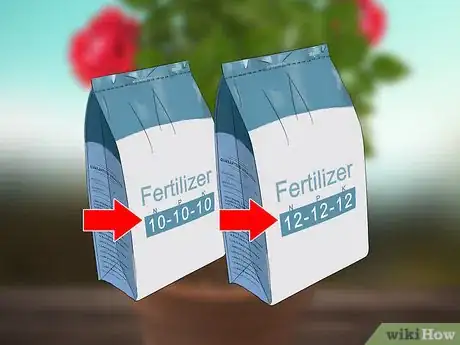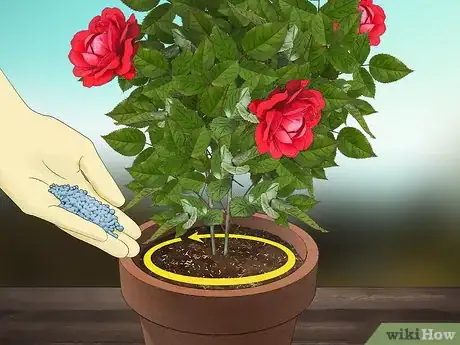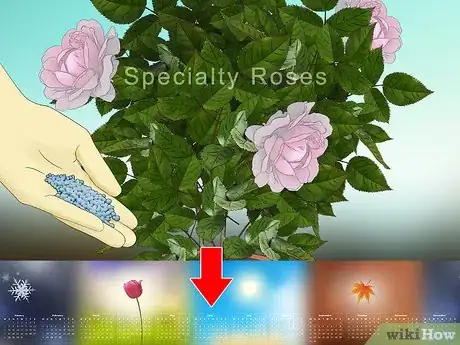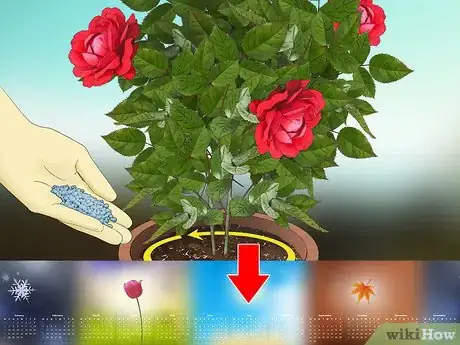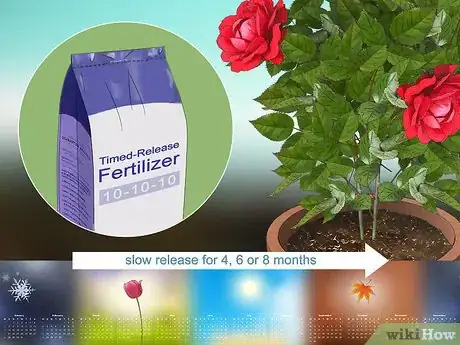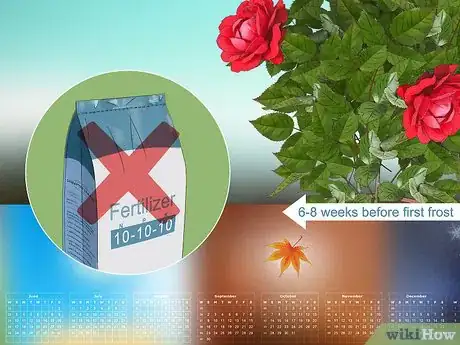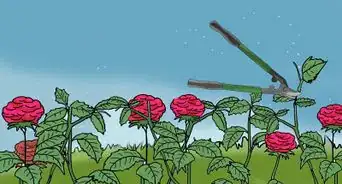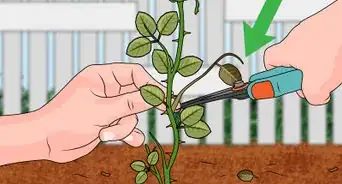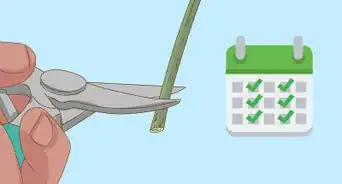This article was co-authored by Lauren Kurtz. Lauren Kurtz is a Naturalist and Horticultural Specialist. Lauren has worked for Aurora, Colorado managing the Water-Wise Garden at Aurora Municipal Center for the Water Conservation Department. She earned a BA in Environmental and Sustainability Studies from Western Michigan University in 2014.
wikiHow marks an article as reader-approved once it receives enough positive feedback. In this case, 100% of readers who voted found the article helpful, earning it our reader-approved status.
This article has been viewed 202,674 times.
Growing beautiful roses requires care and lots of nutrients. You can grow your roses best with a food balance that’s high in nitrogen, phosphorus, and potassium, as well as some secondary nutrients and minerals. Natural fertilizers provide steady nutrients to the soil long-term, and there are many types to choose from. Chemical fertilizers are fast-acting and need only 1-3 applications for the year. Many rose gardeners prefer to combine the two types of fertilizer for the best results.
Steps
Learning to Use Natural Fertilizers
-
1Use natural fertilizers before planting and before your rose’s first bloom. For new and small rose plants, it’s best to use organic fertilizers to avoid burning their delicate roots. Add nutrients to the soil before planting your rose bush, and after you first plant them, with natural fertilizers. Wait until after they bloom the first time before using any chemical fertilizers.[1]
- In early spring, before roses come out of dormancy and start to bloom, using natural fertilizers is the best way to get roses accustomed to new nutrients in the soil.
- Look for fertilizers labeled organic at a local garden supply store, or use the recipes in the homemade fertilizers section.
-
2Apply natural fertilizers every 4 weeks during high growth season. To keep a steady amount of nutrients flowing into your roses’ soil, use natural fertilizers every 4 weeks from early spring until 3-4 weeks before they enter dormancy. Work whatever fertilizer you choose into the upper soil levels.[2]
- Spread solid or granular natural fertilizers in a circle around the top of the soil about 6 in (15 cm) from the base of the bush and work it into the top 2 in (5.1 cm) of soil with a small cultivator.
- Liquid natural fertilizers can be poured in a circle about 6 in (15 cm) from the base of the bush.
Advertisement -
3Stop all fertilization 35-40 days before the first frost date. Applying fertilizers too late in the growing season could cause young, soft growth that’s easily damaged by the first frost. To encourage your roses to begin preparing for winter dormancy, stop fertilizing them 35-40 days, or 6-8 weeks, before the first frost.[3]
- In many areas, this will be around mid-August. Use the first frost prediction for your exact region to be sure.
Making Homemade Fertilizers
-
1Try a blend of Epsom salt with bone, cottonseed, blood, and fish meal to start. A popular early spring natural fertilizer recipe can be made by combining 4 oz (110 g) Epsom salt, 8 oz (230 g) bone meal, 8 oz (230 g) cottonseed meal, 4 oz (110 g) blood meal, and 4 oz (110 g) fish meal. Water your bush thoroughly first, spread the mixture around the base of the plant below its outer perimeter, and work the mixture into the top 2 in (5.1 cm) of soil with a cultivator until it’s buried.[4]
- Water your bush thoroughly again after working the fertilizer into the soil.
- You can find these ingredients at nurseries and garden supply stores that sell natural or organic fertilizers.
-
2Use alfalfa pellets or tea to add many nutrients to your soil. Another natural fertilizer method uses alfalfa pellets. You can use non-food grade ones, sold at garden supply stores, or rabbit food alfalfa pellets. Spread 8–12 oz (230–340 g) of the pellets over the soil under your bush’s outer perimeter, and work it into the top 2 in (5.1 cm) of soil.[5]
- An alternative is to make alfalfa tea. Fill a 30 US gal (110 L) plastic garbage can with 64–80 oz (1,800–2,300 g) alfalfa pellets and the rest with water. Let the mixture sit covered for 3-5 days and stir it once per day, then strain any remaining solids from the water. Water your roses with the tea every 4 weeks during growing season.
-
3Bury banana peels to replenish potassium. To use banana peels, you can either bury them and let them compost before planting your roses, or bury them 4–6 in (10–15 cm) deep under the outer perimeter of your rose bush. They will compost under the ground and provide new sources of potassium for your roses.[6]
- This method is best used in conjunction with another natural method, like coffee grounds or alfalfa pellets.
- Grind the banana peels in a blender or chop them into fine pieces to promote faster composting.
-
4Try coffee grounds for adding nitrogen and potassium. Spread 48 oz (1,400 g) of used coffee grounds on a cookie sheet lined with newspaper. Allow them to dry completely, then sprinkle them around the outer perimeter of your rose bush then water it thoroughly.[7]
- Make a liquid solution of this fertilizer by soaking 48 oz (1,400 g) coffee grounds in 5 gallons (19 L) of water for 2-3 days. Then saturate the soil around the bush in place of watering it one day.
-
5Make a grass and weed clippings solution to enhance your soil. Grass and weeds soak up nutrients from the soil that can be reused as fertilizer. Fill a 5 gallons (19 L) bucket with grass clippings and weeds like nettles, horsetail, and chickweed and add water to the full bucket until it’s full of grass, weeds, and water. Let the bucket sit in the sun for 2 days.[8]
- Dilute 8 fl oz (240 mL) in 80 fl oz (2,400 mL) and use 24 fl oz (710 mL) of it to water a medium rose bush.
-
6Try making compost tea with animal manure if you have it. Use old, dry, composted chicken, cow, or horse manure for this recipe. Wrap some manure in a cloth bag, old towel, or T-shirt and place it at the bottom of a 5 gallons (19 L) bucket. Fill the bucket to the top with water and let it sit in the shade for 3 days.[9]
- Water your roses with the fertilizer as you would normally water it. Discard the “bag” you used and the manure inside after each use or put in a compost pile.
-
7Use dry pet food to add micro-nutrients and protein. Choose a dog or cat dry food with a 3% minimum sodium content. Sprinkle 16 oz (450 g) of it on the soil under the outer perimeter of your bush. Work it 2 in (5.1 cm) deep in the soil with a cultivator and cover the area with cardboard for a week so that animals don’t dig it up.[10]
- Keep the cardboard wet and water your roses through the cardboard just as you would normally water them before removing it.
Applying Chemical Fertilizers
-
1Wait to use chemical fertilizers until plants are well-established in the spring. Using chemical fertilizers too early can burn new or recently dormant rose roots. Wait until after your roses’ very first bloom, and after you prune them in the early spring and see new growth, to use chemical fertilizer.[11]
- This first fertilization is sufficient for most species of roses.
-
2Choose a general-purpose fertilizer of 10-10-10 or 12-12-12. The numbers on fertilizers stand for Nitrogen-Phosphorus-Potassium content. General-use fertilizers have a balance of the 3 nutrients and come in 10-10-10, or 12-12-12, which is a bit stronger. Either is fine to use for most rose types.[12]
-
3Spread 4–8 oz (110–230 g) solid fertilizer in a band 6 in (15 cm) from the plant. For granular fertilizers, work this amount of fertilizer into the top 2 inches (5.1 cm) of soil surrounding your bush with a cultivator. Then water your rose thoroughly.[13]
- Liquid chemical fertilizers have different amount specifications for each dose, so read the instructions carefully before applying them. Remember to only apply chemical fertilizers after the plant is well-established in the spring.
- Always read the instructions for the correct amount of fertilizer before applying it.
-
4Reapply a chemical fertilizer once in mid-June for specialty roses. Some specialty roses, like hybrid teas or floribundas, benefit from a second fertilization in mid-summer. This helps them to stay healthy through the remaining summer months.[14]
- Apply 4–8 oz (110–230 g) of granular fertilizer in a band around the base of your bush.
-
5Do a third application for repeat-blooming roses in mid-July. Still other roses are known to be repeat-bloomers and benefit from a third and final fertilizing in mid-July. This can also be beneficial if you have a particularly long growing season, or plants continue blooming through October and November.[15]
- Follow the same procedures for this application as you did for the first 2 in early spring and mid-summer.
-
6Try a timed-release fertilizer instead of doing multiple applications. If you’d rather do 1 chemical fertilizer application and be done with it for the year, try getting a timed-release fertilizer. These capsule fertilizers release their nutrients throughout the season in either 4, 6, or 8 months.[16]
- Generally these fertilizers use about 4 oz (110 g) per plant and are applied in May, but read the instructions carefully before using them
- Write the dates you apply fertilizer on a calendar to avoid over or underfeeding your roses.
-
7Stop all fertilization 35-40 days before the first frost date. If you apply fertilizers too late in the growing season, you could get young, soft growth that’s easily damaged by the first frost. To encourage your roses to begin preparing for dormancy, stop fertilizing them 35-40 days, or 6-8 weeks, before the first frost.[17]
- In many areas, this will be around mid-August. Use the first frost prediction for your exact region to be sure.
Community Q&A
-
QuestionWhy are my rose leaves turning yellow?
 Community AnswerThat's the first sign the roses are dying. Give it water if it hasn't gotten enough, and maybe add some compost for nutrients.
Community AnswerThat's the first sign the roses are dying. Give it water if it hasn't gotten enough, and maybe add some compost for nutrients. -
QuestionMy rose doesn't grow. No new bud appeared even after 3 weeks. What fertilizer should I use?
 Community AnswerUse vermicompost plus cowdung manure. Use this mixture as organic fertilizer and your plant should start flowering.
Community AnswerUse vermicompost plus cowdung manure. Use this mixture as organic fertilizer and your plant should start flowering. -
QuestionShould I use farm yard manure?
 Community AnswerYes, if possible. Farm yard manure is very good for plants, as long as it doesn't contain any chemicals.
Community AnswerYes, if possible. Farm yard manure is very good for plants, as long as it doesn't contain any chemicals.
References
- ↑ https://www.gardeningknowhow.com/ornamental/flowers/roses/rose-fertilizer.htm
- ↑ https://www.bhg.com/gardening/flowers/roses/feeding-roses/
- ↑ https://extension.illinois.edu/roses/water.cfm
- ↑ https://www.gardeningknowhow.com/ornamental/flowers/roses/rose-fertilizer.htm
- ↑ https://www.gardeningknowhow.com/ornamental/flowers/roses/rose-fertilizer.htm
- ↑ https://plantcaretoday.com/fertilize-roses-naturally.html
- ↑ https://plantcaretoday.com/fertilize-roses-naturally.html
- ↑ https://plantcaretoday.com/fertilize-roses-naturally.html
- ↑ https://plantcaretoday.com/fertilize-roses-naturally.html
- ↑ https://plantcaretoday.com/fertilize-roses-naturally.html
- ↑ https://www.gardeningknowhow.com/ornamental/flowers/roses/rose-fertilizer.htm
- ↑ https://extension.illinois.edu/roses/water.cfm
- ↑ https://extension.illinois.edu/roses/water.cfm
- ↑ https://extension.illinois.edu/roses/water.cfm
- ↑ https://extension.illinois.edu/roses/water.cfm
- ↑ https://extension.illinois.edu/roses/water.cfm
- ↑ https://extension.illinois.edu/roses/water.cfm
About This Article
To fertilize roses, use natural fertilizers before planting and before your rose's first bloom, then switch to chemical fertilizers. You should apply natural fertilizers every 4 weeks from early spring until 6-8 weeks before the first expected frost, which may be around mid-August depending on where you live. If you want to make your own natural fertilizer, try mixing Epsom salt, bone meal, cottonseed meal, blood meal, and fish meal and applying it in early spring. You can also use coffee grounds, which will give your roses nitrogen and potassium. To learn how to use chemical fertilizers, scroll down!
